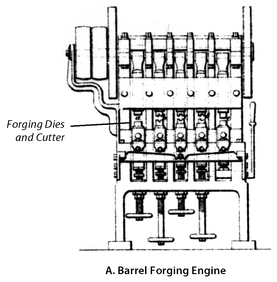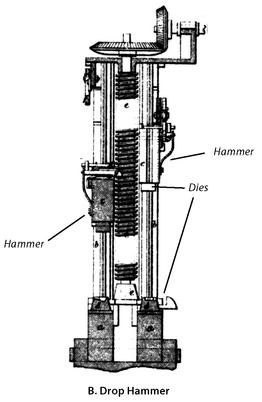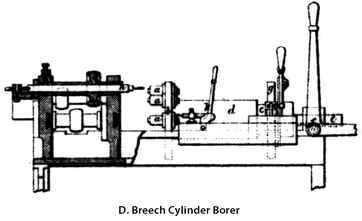The Dawn of Innovation (39 page)
Read The Dawn of Innovation Online
Authors: Charles R. Morris

Colt's first Hartford plant employed about thirty men and was in temporary space. The production was likely a small-scale version of that at Springfield. Much of the machinery came from Nathan Ames, who had long been selling knockoffs of the Springfield equipment; most of the rest were the lathes, dies, tools, patterns, and a furnace that Whitney had bought for the Mexican War contracts. (Naturally there was a prolonged spat over Colt's past-due bills before Whitney released the equipment.)
Within months of getting his temporary plant underway, Colt began construction on a much grander plant that opened in early 1849. The
Hartford Courant
reported that it was “a museum of curious machinery.” For its time, it was a big building, 150 by 50 feet, with “long lines of shafting and machinery . . . performing difficult work and shaping irregular and intricate forms of solid steel as though it were soft as lead.” That same year, the credit service R. G. Dun's reported Colt as “making money, large business, employs 100 hands, good credit.” He completed a new armory in London in 1853 and started work on his last, and most spectacular, plant in Hartford, which opened in 1855. Production soared in the new plant and jumped again with the coming of the Civil War. Colt died in 1862, at only forty-seven, so he missed most of the wartime boom that made his descendants among the richest of Americans. By his death, however, he had sold a quarter million guns.
18
Hartford Courant
reported that it was “a museum of curious machinery.” For its time, it was a big building, 150 by 50 feet, with “long lines of shafting and machinery . . . performing difficult work and shaping irregular and intricate forms of solid steel as though it were soft as lead.” That same year, the credit service R. G. Dun's reported Colt as “making money, large business, employs 100 hands, good credit.” He completed a new armory in London in 1853 and started work on his last, and most spectacular, plant in Hartford, which opened in 1855. Production soared in the new plant and jumped again with the coming of the Civil War. Colt died in 1862, at only forty-seven, so he missed most of the wartime boom that made his descendants among the richest of Americans. By his death, however, he had sold a quarter million guns.
18
The last years of his life were satisfying ones, for he had finally created a stage equal to his self-conception. He married a wealthy young woman in 1856, built a lavish estate on the grounds of his new plant, held forth in Turkish costume at Newport summer soirées, and traveled the world with his wife, sightseeing, art collecting, and selling arms to distant potentatesâ
all the while badgering his managers for details of their operations. The cause of his death was variously listed as “gout” or “rheumatism” but was probably a result of three decades of hard living combined with the day's lethally ignorant doctoring.
The London Armoryall the while badgering his managers for details of their operations. The cause of his death was variously listed as “gout” or “rheumatism” but was probably a result of three decades of hard living combined with the day's lethally ignorant doctoring.
Most of the information on Colt's most advanced production processes comes from his London factory. A few months after being lionized at the Crystal Palace Exhibit, Colt became the first American to be invited to speak at the prestigious British Institution of Civil Engineers, and he was later awarded an engineering medal. The talk, in November 1851, was heavily attended, with both British and American government and military luminaries in the audience. The discussion following the presentation extended over two evenings. Opinion was virtually unanimous on the virtues of the weapons, as was the amazement that they had been made by machinery. In Colt's words: “Machinery is now employed by the Author, to the extent of about eight-tenths of the whole cost of construction of these fire-arms; he was induced gradually to use machinery to so great an extent, by finding that with hand-labour it was not possible to obtain that amount of uniformity, or accuracy in the several parts, which is so desirable, and also because he could not otherwise get the number of arms made, at anything like the same cost, as by machinery.”
19
19
The intense interest in Colt's talk stemmed from an evolving crisis in British military arms procurement. Weapons requirements had dropped off sharply during the aristocratic stability that followed the Napoleonic wars. But as black war clouds gathered at mid-century, the military small arms industry had become slothful and stagnant, quite unequal to the task before them. Military gun making was concentrated in Birmingham and organized into forty-eight different trades and subtrades, all of them working by traditional methods. Each trade made its particular pieces and shipped them to the government for inspection. The proved work then went to highly skilled fitters, who assembled guns by hand-filing. While
many of the craftsmen were superb, the process was wasteful, and the quality of work had deteriorated considerably. Nor was there much hope of reform, for the crafts were in full control of the shop floor.
20
many of the craftsmen were superb, the process was wasteful, and the quality of work had deteriorated considerably. Nor was there much hope of reform, for the crafts were in full control of the shop floor.
20
Desperate for a solution, the doyens of British engineering grasped at the idea of attacking the problem with machinery, vaguely defined as the American system of manufacturing. James Nasmyth was one of the witnesses before a parliamentary committee looking into the advisability of greater reliance on machinery in arms making. Asked how he could be so sure that the British trade would benefit from more machinery, Nasmyth retorted:
Then I should ask why are the gunmakers of Birmingham so much at the mercy of their men; if they have that quantity of machinery that I think is applicable to gunmaking, they ought to be quite independent of those men, and not be knuckling down to them as they are.... I may quote Mr. Brazier as giving me that information.
[Committee] What account did Mr. Brazier give you?âThat he has been tormented out of his life by his men striking.
21
21
To Colt, the undisguised British admiration for American machinery looked like Opportunity writ large. When he left London in 1852, he was determined to return and open an armory. In the meantime, John Anderson, a senior civil servant with Ordnance responsibilities, created an expert delegation to travel to America to inform themselves on American applications of machinery, especially with reference to firearms. The fact that it was coheaded by Joseph Whitworth attests the high importance accorded the investigation. The group spent the summer and early fall of 1853 in the United States, with Whitworth focusing on metal trades and gun making, while the other cohead, George Wallis, one of Great Britain's leading educators, investigated a broader rage of industries.
Moving with his usual alacrity, Colt had his London plant up and running on the banks of the Thames by January 1853, and it quickly became something of a tourist attraction for the British intelligentsia. By the time
the Whitworth and Wallis groups returned from the United States and produced their initial reports, the new armory had been open for a year and was a convenient reference point for the parliamentary hearings that commenced in the spring of 1854.
22
the Whitworth and Wallis groups returned from the United States and produced their initial reports, the new armory had been open for a year and was a convenient reference point for the parliamentary hearings that commenced in the spring of 1854.
22
The best available description of the armory is in a two-part 1855 article in the
London Journal of Arts and Sciences
that includes detailed line drawings of the major machines. The opening sentence says it all: “The establishment of a fire-arm manufactory at Thames-Bank Vauxhall, by Colonel Colt, is a fact from which we shall ere long have to date an entire revolution in the production of small arms in this country.”
23
London Journal of Arts and Sciences
that includes detailed line drawings of the major machines. The opening sentence says it all: “The establishment of a fire-arm manufactory at Thames-Bank Vauxhall, by Colonel Colt, is a fact from which we shall ere long have to date an entire revolution in the production of small arms in this country.”
23
The new armory was in a leased brick building, some 350 feet long, with a deep basement and three stories. The basement space was devoted to the heavy machinery used to make the factory's machine tools; the first and second floors to multiple turning, boring, and milling machines; and the top floor to polishing, fitting, and final assembly. Large sheds in the yards were for carpenters and smiths, and housed a row of steam hammers, the drop forge, and associated furnaces. The steam engine was in the basement connected to a separate boiler house. Next to the plant was a well-kept garden area and a sales office and showroom.
24
24
The factory was a pinnacle for Rootâa marked advance over his Collinsville machinery, with the same attention to detailed process flow. In the smiths' sheds, for example, the forges allowed two smiths to work on a furnace at the same time, and the grates arrangement did not immerse the bars in fire, so their color could be readily observed. The barrel forging machines, built for octagonal barrels, each comprised four consecutive barrel-length dies and a cutter. The worker took a steel bar at the proper heat, placed it and pressed it in each die in sequence, and trimmed itâ“shaping out the barrels, one after the other, with great rapidity.”
25
25
Of the machines in the shed, the drop forger drew the most comment. It was built as a rectangle with V-bar slides for drop hammers on each vertical corner. Two workers were normally in attendance, each managing two hammers. The heavy screw drive in the center was constantly in motion, lifting the hammers. A simple latch device allowed the attendants to place each hammer to any level on the slide to tune the force of the blow.
After a hammer was released and dropped, it automatically reengaged with the drive and was lifted to either a preset height or the top of the forge, where it disengaged and remained in place until released again. Cast dies on the hammer and its drop site closed completely around the hot metal to minimize irregularities. The very heavy construction and extreme precision of the screw drive and the V-bar slides produced highly exact forgings, minimizing milling and filing.
After a hammer was released and dropped, it automatically reengaged with the drive and was lifted to either a preset height or the top of the forge, where it disengaged and remained in place until released again. Cast dies on the hammer and its drop site closed completely around the hot metal to minimize irregularities. The very heavy construction and extreme precision of the screw drive and the V-bar slides produced highly exact forgings, minimizing milling and filing.
That same intelligence was displayed throughout the plant. Colt's barrels were bored, rather than hammer-welded or rolled, for greater integrity. The barrel-boring machine had a lever device that allowed the bore to be withdrawn straight out for lubrication, in place of the usual slow reverse rotation. The rifling machine rifled four barrels at a time, automatically resetting the tool placement for the six or seven grooves that were standard for Colt pistols. The breech cylinders were bored in two machines: the first made three progressively finer bores in each chamber location; the second involved four separate boring and finishing tools operating on the six chambers of eight target cylinders on a rotating wheel. All the tool placements and workpiece adjustments were accomplished by self-acting cams. There were dozens of other machines operating on similar principles.
Great Britain's wide-eyed reaction to the London armory was fully warranted. Colt's plants in London and Hartford were the most advanced precision-manufacturing operations in the world, far in advance of any of the American armories. When the British investigators toured the Springfield Armory, for instance, they were much impressed with the Blanchard stocking machinery. But they were surprised that the line was not set up for a true process flow. When the great machinist Cyrus Buckland reconstructed the Blanchard line, he used fifteen different machines. The times required for the different machines to do their specific tasks naturally varied, so the slower machines were bottlenecks. At Collinsville, and at Colt, Root naturally multiplied the slower machines to keep the flow even and all machines occupied, which seems just common sense. But for thirty-five years, the armories either didn't notice or, since they were working to a quota, not a profit line, had no incentive to run full.
Colt London Armory Machines: from 1855
London Journal of Arts and Sciences
London Journal of Arts and Sciences
Â
A.
Two-dimensional end view of forging engine. A hot bar was rapidly forged and cut in the row of tools indicated.
Two-dimensional end view of forging engine. A hot bar was rapidly forged and cut in the row of tools indicated.

Â
B.
The drop hammers and dies (indicated) manufactured near-finished forgings. Note the different drop heights of the two hammers shown. An airburst cleanses the dies after each pass.
The drop hammers and dies (indicated) manufactured near-finished forgings. Note the different drop heights of the two hammers shown. An airburst cleanses the dies after each pass.

Â
C.
The rifling machine rifled four barrels at a time, automatically resetting to each of the six or seven grooves in a pistol.
The rifling machine rifled four barrels at a time, automatically resetting to each of the six or seven grooves in a pistol.

Â
D.
The machine applied four separate finishing operations to each of the six chambers of eight cylinders mounted on a wheel. Tool changes and workpiece management were all self-acting, except that an attendant pulled a lever to move a fresh cylinder to the cutting tool station.
The machine applied four separate finishing operations to each of the six chambers of eight cylinders mounted on a wheel. Tool changes and workpiece management were all self-acting, except that an attendant pulled a lever to move a fresh cylinder to the cutting tool station.

Other books
The Best American Mystery Stories 2012 by Otto Penzler
Oceanic by Egan, Greg
Cuestión de fe by Donna Leon
Thy Neighbor by Norah Vincent
Baby Be-Bop by Francesca Lia Block
Claiming Chase: (A Second Chance Stepbrother Romance) by Eve, Charlotte
Papelucho Detective by Marcela Paz
Blood of Dragons by Bonnie Lamer
Murder on Bamboo Lane by Naomi Hirahara